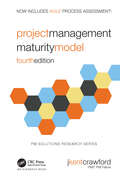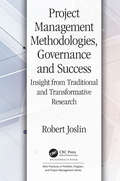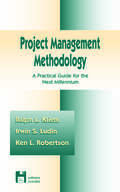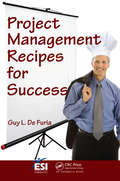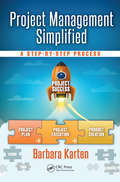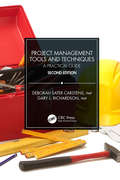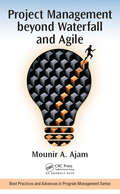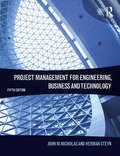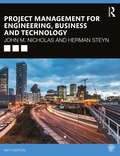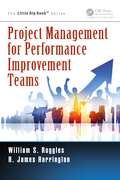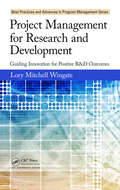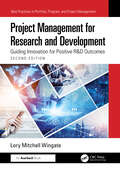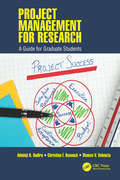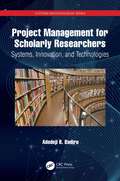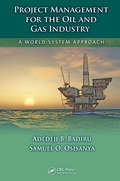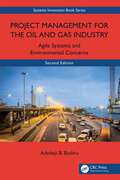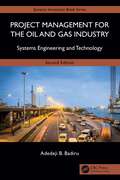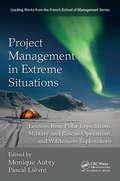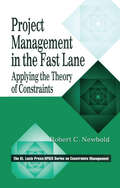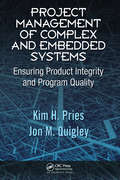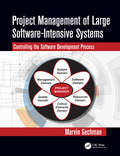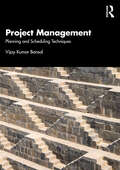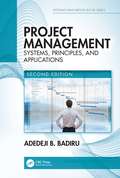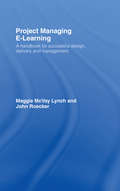- Table View
- List View
Project Management Maturity Model (PM Solutions Research)
by J. Kent CrawfordAssisting organizations in improving their project management processes, the Project Management Maturity Model defines the industry standard for measuring project management maturity and agile and adaptive capabilities. Project Management Maturity Model, Fourth Edition provides a roadmap showing organizations how to move to higher levels of organizational behavior, improving project success and organizational performance. It's a comprehensive tool for enhancing project management practices, covering areas critical to organizational improvement, such as the project management office, management oversight, and professional development. It also provides methods for optimizing project management processes and suggestions for deploying the model as a strategic tool in improving business outcomes. New material in each chapter also outlines good practices for implementing adaptive an agile processes. The book also includes the Project Portfolio Management Maturity Model, which covers best practices for determining portfolio maturity, setting short-term priorities, implementing benefits realization management, improving portfolio management processes and tracking progress. The author, J. Kent Crawford, CEO of PM Solutions, describes the basics of project management maturity, including the benefits of assessing maturity, and presents a comprehensive framework for improving organization's processes. Chapters are based on the ten project management knowledge areas specified in the Project Management Institute's standard, the PMBOK® Guide. This edition provides new and revised materials based on the PMBOK® Guide including a fresh focus on agile and adaptive methods, benefits realization, and organizational change management. This book's fourth edition features: Determine the maturity of your organization's project management processes Gauge readiness for agile transformation Map out a logical path to improve your organization's processes Set priorities for short-term process improvement action Track and visualize improvements in project management over time Learn to translate process maturity into business results After an objective assessment, an organization can set its goals for increasing the capability of its processes and develop a plan for reaching those goals. This book is ideal for anyone involved with improving the capability of an organization's project and portfolio management processes.
Project Management Methodologies, Governance and Success: Insight from Traditional and Transformative Research (Best Practices and Advances in Program Management)
by Robert JoslinProject management methodologies, practices, and guidelines are the only explicit information that project managers have and, when properly maintained, should reflect the most current knowledge and guidance to achieve repeatable successful project outcomes. Despite more than 50 years of research in the field of project management, project success r
Project Management Methodology: A Practical Guide for the Next Millenium
by Ralph L. Kliem Irwin S. Ludin Ken L. RobertsonThis work introduces Practical Project Management Methodology (P2M2), an international joint venture developed by three experienced project managers the provide useful steps applicable throughout the life cycle of a variety of projects. It covers areas from leading, defining and planning to organizing, controlling and closing. The two disks include
Project Management Recipes for Success (ESI International Project Management Series)
by Guy L. De FuriaGrounded in practicality, this book explains the procedures for running a successful project and highlights the finer points of managing and controlling the project. Written specifically for those responsible for the hands-on managing of projects, it is also useful to program managers and senior executives. Project managers will gain the confidence that comes from following a good recipe for success. Program managers will gain a perspective on the myriad of activities their project managers must perform to achieve a well-disciplined project.
Project Management Simplified: A Step-by-Step Process (Systems Innovation Book Ser.)
by Barbara KartenAre projects a problem for you? Do your projects cost too much, take too long, or are just not quite right? If so, Project Management Simplified: A Step-by-Step Process is the book for you. It applies well-defined processes for managing projects to managing change in our lives. It describes an approach modeled on a process used successfully in busi
Project Management Tools and Techniques: A Practical Guide, Second Edition
by Gary L. Richardson Deborah Sater CarstensThe topic of project management is truly an evolution of art seeking science. This activity involves balancing project objectives against the constraints of time, budget, and quality. Achieving this balance requires skill, experience, along with the use of many tools, and techniques which are the focus of this book. This new edition provides updated content to incorporate examples from Microsoft Project 2016 and material from the Project Management Body of Knowledge (PMBOK® Guide), sixth edition. The chapter structure includes step-by-step instructions regarding the basic mechanics and various software tools that can be used to assist in the processes. To reinforce the textbook’s learning objectives, extra material is provided on the textbook website. This includes mechanical tool examples and lab assignments representative of the chapter topics. An external video tutorial library is available to help with various mechanics related to Microsoft Project mechanics. An instructor manual is available for qualifying adoptions for classroom use. Features Illustrates the use of Microsoft Project throughout the project life cycle Offers templates as productivity enhancement tools Includes supplemental material for students and instructors Provides assignments for hands-on experience Follows the PMI PMBOK ® Guide model structure that will support a better understanding of the model and help prepare students for PMP and CAPM certification Illustrates both traditional and contemporary management techniques
Project Management beyond Waterfall and Agile (Best Practices in Portfolio, Program, and Project Management)
by Mounir AjamThis book goes beyond the paint by numbers approach, transcending the "how" of project management to the "what" and "why," which is critical for leaders of change. — Dr. Joel B. Carboni, President and Founder, GPM Global and President, IPMA-USA <P><P> Project Management beyond Waterfall and Agile presents a flexible, universal, and integrated three-dimensional model for managing projects, the Customizable and Adaptable Methodology for Managing Projects™ (CAMMP™ ). By tailoring and customizing the model to a specific industry or organization and by adapting it to a function or project classification, this model can be used to manage any project. CAMMP™ can also be used both in a traditional or an Agile environment. CAMMP™ integrates leading concepts on competence, processes, and sustainability. The model’s three dimensions are project lifecycle, project management processes, and, finally, competence, sustainability, and best practices. The book explains how to integrate these dimensions to manage a project across the three dimensions and the project stages. CAMMP™ is a stage-gate process, which is vital for project success. <P><P>The current state of practice in project management is not sustainable. The root causes of this problem include a lack of standardized processes, missing methods or methodological approaches, and no real organizational system for managing projects. <P><P>This book introduces a system to address these shortcomings. It focuses on the elements of this system, which is a practical and systematic methodological approach for managing and delivering all types of projects. <P><P>CAMMP™ integrates the best learning from the various global associations in the field. The book distills the experience and knowledge of a practitioner working in different roles for more than three decades on various types of projects of all sizes and complexities. It is a practical book by a practitioner writing for practitioners.
Project Management for Engineering, Business and Technology
by Herman Steyn John M. NicholasProject Management for Engineering, Business and Technology, 5th edition, addresses project management across all industries. First covering the essential background, from origins and philosophy to methodology, the bulk of the book is dedicated to concepts and techniques for practical application. Coverage includes project initiation and proposals, scope and task definition, scheduling, budgeting, risk analysis, control, project selection and portfolio management, program management, project organization, and all-important "people" aspects—project leadership, team building, conflict resolution and stress management. The Systems Development Cycle is used as a framework to discuss project management in a variety of situations, making this the go-to book for managing virtually any kind of project, program or task force. The authors focus on the ultimate purpose of project management—to unify and integrate the interests, resources and work efforts of many stakeholders, as well as the planning, scheduling, and budgeting needed to accomplish overall project goals. This new edition features: Updates throughout to cover the latest developments in project management methodologies New examples and 18 new case studies throughout to help students develop their understanding and put principles into practice A new chapter on agile project management and lean Expanded coverage of program management, stakeholder engagement, buffer management, and managing virtual teams and cultural differences in international projects Alignment with PMBOK terms and definitions for ease of use alongside PMI certifications Cross-reference to IPMA, APM, and PRINCE2 methodologies Extensive instructor support materials, including an Instructor’s Manual, PowerPoint slides, answers to chapter review questions, problems and cases, and a test bank of questions. Taking a technical yet accessible approach, Project Management for Business, Engineering and Technology, 5th edition, is an ideal resource and reference for all advanced undergraduate and graduate students in project management courses as well as for practicing project managers across all industry sectors.
Project Management for Engineering, Business and Technology
by Herman Steyn John M. NicholasProject Management for Engineering, Business and Technology is a highly regarded textbook that addresses project management across all industries. First covering the essential background, from origins and philosophy to methodology, the bulk of the book is dedicated to concepts and techniques for practical application. Coverage includes project initiation and proposals, scope and task definition, scheduling, budgeting, risk analysis, control, project selection and portfolio management, program management, project organization, and all-important "people" aspects—project leadership, team building, conflict resolution, and stress management. The systems development cycle is used as a framework to discuss project management in a variety of situations, making this the go-to book for managing virtually any kind of project, program, or task force. The authors focus on the ultimate purpose of project management—to unify and integrate the interests, resources and work efforts of many stakeholders, as well as the planning, scheduling, and budgeting needed to accomplish overall project goals. This sixth edition features: updates throughout to cover the latest developments in project management methodologies; a new chapter on project procurement management and contracts; an expansion of case study coverage throughout, including those on the topic of sustainability and climate change, as well as cases and examples from across the globe, including India, Africa, Asia, and Australia; and extensive instructor support materials, including an instructor’s manual, PowerPoint slides, answers to chapter review questions and a test bank of questions. Taking a technical yet accessible approach, this book is an ideal resource and reference for all advanced undergraduate and graduate students in project management courses, as well as for practicing project managers across all industry sectors.
Project Management for Performance Improvement Teams (The Little Big Book Series)
by H. James Harrington William S. RugglesProject Management for Performance Improvement Teams (or, PM4PITs, for short) provides practical guidance based on innovative concepts for project teams -- especially Performance Improvement Teams (PITs)—and their Project Managers on how to successfully complete individual projects and programs using an ingenious and scalable framework based on an innovative foundation fusing together elements of Project Management, Innovation Management, and Continual Improvement. This book lays out how Project and Program Managers and their teams can "do those right projects the right way," one project at a time. It details what continual improvement, change, and innovation are, why they are so important, and how they apply to performance improvement—both incremental and transformative. The authors examine the four types of work and workforce management in organizations, Strategic, Operations, Projects, and Crises, using four common comparative variables: Proactive/Preventive versus Reactive/Corrective, Temporary/Unique versus Ongoing/Repetitive, Innovative versus Maintaining the Status Quo, and Schedule Focus: Fiscal Year versus Short Term versus Long Term. These comparisons set the stage for the uniqueness of the third type: Projects (and Programs) that are fundamentally change-driven.
Project Management for Research and Development: Guiding Innovation for Positive R&D Outcomes (Best Practices in Portfolio, Program, and Project Management #10)
by Lory Mitchell WingateToday's leading organizations recognize the importance of research and development (R&D) to maintain and grow market share. If companies want to survive into the future, they must accelerate their R&D-to-market cycles or find themselves behind the competition.Project Management for Research and Development: Guiding Innovation for Positive R
Project Management for Research and Development: Guiding Innovation for Positive R&D Outcomes (Best Practices in Portfolio, Program, and Project Management)
by Lory Mitchell WingateResearch and development (R&D) activities do not fit the traditional project model. They may seem difficult to manage because of their inherent ambiguity, the need for creative exploration, and often the lack of having defined milestones and outcomes. However, project management methods, along with systems engineering as a complementary discipline, provide the ability to categorize R&D activities, bound them, and then assess progress along a defined course of action. They also provide information about status and progress, visibility into opportunities and challenges that might otherwise be missed, allowing timely course corrections.Project Management for Research and Development: Guiding Innovation for Positive R&D Outcomes, Second Edition, provides methods for optimizing results in R&D by using structured processes that come from project management and are intertwined with the key complementary discipline of systems engineering. It provides processes, tools, and techniques to assess and manage creative activities in an optimal way. The core of the book is a flexible framework, which lifts the burden off organizations that do not want to invest heavily in implementing a significant number of often conflicting processes. It is a lightweight, flexible structure to help organizations and individuals meet their most important goals, no matter how complicated or complex these goals may be.Each chapter in the book includes Apply Now exercises, which allow immediate application of fundamental concepts, summarizes key points of concepts and terms, and provides templates to apply the ideas from each chapter to a real-life situation. The book also features unique and creative case studies to demonstrate the application of project management to various R&D projects.
Project Management for Research: A Guide for Graduate Students (Systems Innovation Book Series)
by Adedeji B. Badiru Vhance V. Valencia Christina F. RusnockGraduate research is a complicated process, which many undergraduate students aspire to undertake. The complexity of the process can lead to failures for even the most brilliant students. Success at the graduate research level requires not only a high level of intellectual ability but also a high level of project management skills. Unfortunately, many graduate students have trouble planning and implementing their research. Project Management for Research: A Guide for Graduate Students reflects the needs of today’s graduate students. All graduate students need mentoring and management guidance that has little to do with their actual classroom performance. Graduate students do a better job with their research programs if a self-paced guide is available to them. This book provides such a guide. It covers topics ranging from how to select an appropriate research problem to how to schedule and execute research tasks. The authors take a project management approach to planning and implementing graduate research in any discipline. They use a conversational tone to address the individual graduate student. This book helps graduate students and advisors answer most of the basic questions of conducting and presenting graduate research, thereby alleviating frustration on the part of both student and advisor. It presents specific guidelines and examples throughout the text along with more detailed examples in reader-friendly appendices at the end. By being more organized and prepared to handle basic research management functions, graduate students, along with their advisors, will have more time for actual intellectual mentoring and knowledge transfer, resulting in a more rewarding research experience.
Project Management for Scholarly Researchers: Systems, Innovation, and Technologies (Systems Innovation Book Series)
by Adedeji B. BadiruThis book presents practical guidelines for university research and administration. It uses a project management framework within a systems perspective to provide strategies for planning, scheduling, allocating resources, tracking, reporting, and controlling university-based research projects and programs. Project Management for Scholarly Researchers: Systems, Innovation, and Technologies covers the technical and human aspects of research management. It discusses federal requirements and compliance issues, in addition to offering advice on proper research lab management and faculty mentoring. It explains the hierarchy of needs of researchers to help readers identify their own needs for their research enterprises. This book provides rigorous treatment and guidance for all engineering fields and related business disciplines, as well as all management and humanities fields.
Project Management for the Oil and Gas Industry: A World System Approach (Systems Innovation Book Series)
by Adedeji B. Badiru Samuel O. OsisanyaThis book presents an integrated approach to project management for oil and gas projects. It covers concepts, tools, and techniques of project management based on the elements of the Project Management Body of Knowledge. The book also contains case examples of applications of project management tools and techniques to real-life project scenarios. The book is intended to serve as a reference book for planners, project operators, stakeholders, designers, project managers, business managers, consultants, project analysts, senior executives, project team members, members of project management office, project customers, functional managers, trainers, and researchers.
Project Management for the Oil and Gas Industry: Agile Systems and Environmental Concerns (Systems Innovation Book Series)
by Adedeji B. BadiruA lot of managerial finessing is needed to handle the present era of the operations of the oil and gas industry, under the pressure of environmental issues. The recent emergence of the techniques of Agile systems offers a tremendous collection of new approaches for addressing the managerial impediments to oil and gas operations.Agile Systems and Environmental Concerns covers how Agile systems are based on principles that emphasize team collaboration, continual planning, and continual learning, thus making an operation more responsive and adaptive to operational changes. Agile is an iterative approach to project management that helps teams achieve results faster and more accurately.This volume contains a variety of Agile management tools and techniques to address communication, cooperation, and coordination requirements related to risk management and environmental issues, ideal for practitioners, designers, consultants, contractors, risk and quality managers, along with project managers and systems engineers involved in oil and gas projects, and related industries.
Project Management for the Oil and Gas Industry: Systems Engineering and Technology (Systems Innovation Book Series)
by Adedeji B. BadiruThis volume focuses on the broad scope of systems engineering and recent energy technology developments as they relate to the oil and gas industry, which remains a lifeline to communities around the world. In 2015, the United Nations adopted the 17 Sustainable Development Goals (SDGs) to, among other things, curtail the catastrophe that will befall the world from the increasing menace of global warming and climate change. The best way to achieve most or all the goals is to use a comprehensive systems-based approach, specifically, leveraging the efficacy of systems engineering for project management in the oil and gas industry.Systems Engineering and Technology presents the systems-based interrelationships of energy generation, transmission, distribution, and consumption. This volume will expand on elements of the first edition to encapsulate new developments in technologies, from a systems approach. In tackling climate change problems, both qualitative and quantitative approaches must be pursued. This allows us to bring in technological approaches as well as human-centered social considerations.The premise of this volume is that a systems engineering approach is the key to making the desired progress, where renewables and conventional oil and gas can coexist. This book contains a mix of technical, social, economic, engineering, and political considerations ideal for practitioners, designers, consultants, contractors, risk and quality managers, along with project managers and systems engineers involved in oil and gas projects, and related industries.
Project Management in Extreme Situations: Lessons from Polar Expeditions, Military and Rescue Operations, and Wilderness Exploration (Leading Works from the French School of Management)
by Monique Aubry Pascal LievreThe growing complexity of projects today, as well as the uncertainty inherent in innovative projects, is making obsolete traditional project management practices and procedures, which are based on the notion that much about a project is known at its start. The current high level of change and complexity confronting organizational leaders and managers requires a new approach to projects so they can be managed flexibly to embrace and exploit change. What once used to be considered extreme uncertainty is now the norm, and managing planned projects is being replaced by managing projects as they evolve. <P><P>Successfully managing projects in extreme situations, such as polar and military expeditions, shows how to manage successfully projects in today’s turbulent environment. Executed under the harshest and most unpredictable conditions, these projects are great sources for learning about how to manage unexpected and unforeseen situations as they occur. This book presents multiple case studies of managing extreme events as they happened during polar, mountain climbing, military, and rescue expeditions. <P><P>A boat accident in the Artic is a lesson on how an effective project manager must be ambidextrous: on one hand able to follow plans and on the other hand able to abandon those plans when disaster strikes and improvise new ones in response. Polar expeditions also illustrate how a team can use "weak links" to go beyond its usual information network to acquire strategic information. Fire and rescues operations illustrate how one team member’s knowledge can be transferred to the entire team. Military operations provide case material on how teams coordinate and make use of both individual and collective competencies. <P><P>This groundbreaking work pushes the definitions of a project and project management to reveal new insight that benefits researchers, academics, and the practitioners managing projects in today’s challenging and uncertain times.
Project Management in the Fast Lane: Applying the Theory of Constraints (The CRC Press Series on Constraints Management)
by Robert C. NewboldThis cutting edge, "how to" manual details proven methods for turning around chronically late, overbudget, and underperforming projects. Project Management in the Fast Lane explains how Theory of Constraints tools can be applied to achieve effective, breakthrough solutions in virtually any environment. It includes a complete discussion of the Criti
Project Management of Complex and Embedded Systems: Ensuring Product Integrity and Program Quality
by Jon M. Quigley Kim H. PriesThere are many books on project management and many on embedded systems, but few address the project management of embedded products from concept to production. Project Management of Complex and Embedded Systems: Ensuring Product Integrity and Program Quality uses proven Project Management methods and elements of IEEE embedded software develop
Project Management of Large Software-Intensive Systems
by Marvin GechmanThe book describes how to manage and successfully deliver large, complex, and expensive systems that can be composed of millions of line of software code, being developed by numerous groups throughout the globe, that interface with many hardware items being developed by geographically dispersed companies, where the system also includes people, policies, constraints, regulations, and a myriad of other factors. It focuses on how to seamlessly integrate systems, satisfy the customer’s requirements, and deliver within the budget and on time. The guide is essentially a “shopping list” of all the activities that could be conducted with tailoring guidelines to meet the needs of each project.
Project Management: Planning and Scheduling Techniques
by Vijay Kumar BansalProject Management:Planning and Scheduling Techniques is a highly readable guide to the essentials of project planning, scheduling, and control aimed at readers looking for an introduction to the core concepts of planning and scheduling, including the ‘Critical Path Method’, but also the ‘Precedence Diagramming Method’, the ‘Line of Balance’ technique, and the ‘Programme Evaluation and Review Technique’. This book explains the theory behind the methods and makes effective use of learning outcomes, exercises, diagrams, and examples to provide clear and actionable knowledge for students and project managers. The book can be used as a classroom textbook or as a self-study guide for project managers taking their professional qualifications, and it includes examples from a wide range of project management scenarios. It is suitable for planning and scheduling courses in the fields of industrial, civil, and mechanical engineering, construction, and management.
Project Management: Systems, Principles, and Applications, Second Edition (Systems Innovation Book Series)
by Adedeji B. BadiruThe goal of the new edition is to continue with a systems view of the world. For a more robust and worldwide market dissemination, the new edition has changed to a reference book. The project systems approach to project management, is needed in executing projects across countries and across cultures, which is a crucial requirement in today's globalized and intertwined economics. The book uses ample graphical representations to clarify the concepts and techniques presented. The case examples help to reinforce the topics covered. Several illustrative examples and practice exercises are included. Each chapter is updated and new chapters include Project Simulation and Project Templates. A new chapter on managing complex projects in an age of artificial intelligence adds a unique value to the book. Features Highlights contemporary best practices of project management Uses a systems framework to integrate quantitative and qualitative tools Offers illustrative examples and practice exercises Covers project schedule performance appraisal techniques Discusses the knowledge areas contained in the Project Management Book of Knowledge (PMBOK) Presents software applications for project management, as well as case examples
Project Managing E-Learning: A Handbook for Successful Design, Delivery and Management
by John Roecker Maggie McVay LynchProject Managing E-learning provides an essential framework, based on the globally accepted IPECC model, for planning, designing, delivering, managing and evaluating e-learning projects successfully. It focuses on practical, easy-to-understand methods and offers applications of project management principles in the real world. Illustrated by case studies of projects undertaken in business and academia it provides a step-by-step guide and highlights where projects typically fail. Each chapter begins with a definition and conceptualisation of the process, provides examples of how the process steps may vary dependent on organization or project size and discusses the typical problems organisations face when performing steps in the project management process. Covering all of the essentials as well as cutting-edge technology, it guides designers and managers through all stages of implementing and managing a project. Selected themes include: using focus groups gaining sponsors risk management pedagogical considerations testing quality control how to know when trouble is imminent PM software systems podcasting. The practical framework and sound advice offered in Project Managing E-learning is essential reading for all those who want to successfully implement and manage high quality e-learning in both academic and corporate training settings on time and to budget.
Project Planning and Project Success: The 25% Solution (Best Practices In Portfolio, Program, And Project Management Ser. #15)
by Pedro SerradorProject planning is generally accepted as an important contributor to project success. However, is there research that affirms the positive impact of project planning and gives guidance on how much effort should be spent on planning? To answer these questions, this book looks at current literature and new research of this under-studied area of proj
